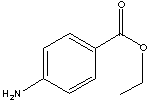| CAS
NO. |
94-09-7 |

|
| EINECS NO. |
202-303-5 |
| FORMULA |
H2NC6H4CO2C2H5 |
| MOL
WT. |
165.19 |
|
H.S.
CODE
|
|
|
TOXICITY
|
Oral rat LD50:
3040 mg/kg |
| SYNONYMS |
Benzocaine; 4-Aminobenzoic acid ethyl ester; |
|
Ethyl 4-Aminobenzoate; Ethyl p-aminobenzoate;
Ethylester kyseliny p-aminobenzoove; |
|
SMILES |
|
|
CLASSIFICATION
|
|
|
PHYSICAL AND CHEMICAL PROPERTIES
|
| PHYSICAL
STATE |
white to pale yellow
crystalline powder |
| MELTING POINT |
89
- 92 C |
| BOILING
POINT |
172 C |
| SPECIFIC GRAVITY |
|
| SOLUBILITY
IN WATER |
|
| pH |
|
| VAPOR DENSITY |
|
|
AUTOIGNITION
|
|
|
NFPA
RATINGS
|
|
|
REFRACTIVE
INDEX
|
|
| FLASH
POINT |
> 110 C |
| STABILITY |
Stable
under ordinary conditions. |
|
APPLICATIONS
|
|
Ethyl Aminobenzoate is used in as a local anaesthetic applied to medicines and
cosmetics. It releases pain temporarily
with
the fuction of nerve numb. It is used as an intermedaite for the synthesis other chemical compounds.
|
| SALES
SPECIFICATION (BP/USP) |
|
APPEARANCE
|
White crystalline powder |
|
ASSAY |
99.5%
min |
|
CLARITY
IN EtOH
|
Pass
|
|
MELTING POINT |
89
- 92 C |
|
WATER
|
0.2%
max
|
|
RESIDUE
ON IGNITION
|
0.1%
max
|
|
Fe
|
40ppm
max
|
|
SULFATE
|
Pass
|
|
CHLORIN
|
Pass
|
| TRANSPORTATION |
| PACKING |
25kgs
in fiber drum |
| HAZARD CLASS |
|
| UN
NO. |
|
| OTHER
INFORMATION |
|
Hazard
Symbols: n/a, Risk Phrases: n/a, Safety
Phrases: 24/25 |
|
GENERAL
DESCRIPTION OF LOCAL ANESTHETC
|
|
Local anesthetic is a substance that causes loss of sensation only to the area
to which it is applied without affecting consciousness. Most local anesthetics
structures have amino-ester or an amino-amide group which are linked to
hydrophilic (secondary or tertiary amine) and to hydrophobic group (aromatics)
on the other sid. The ester can be hydrolysed in plasma by the enzyme pseudocholinesterase into para-aminobenzoic
acid. Amide is stable for longer
acting and more systemic distribution. Ester types include Procaine (Novocain),
Chloroprocaine (Nesacaine), Cocaine, Tetracaine (Pontocaine), Benzocaine,
Tetracaine. Amide types include Lidocaine (Xylocaine), Mepivacaine(Carbocaine),
Prilocaine (Citanest), Bupivacaine (Marcaine), Etidocaine (Duranest). |
